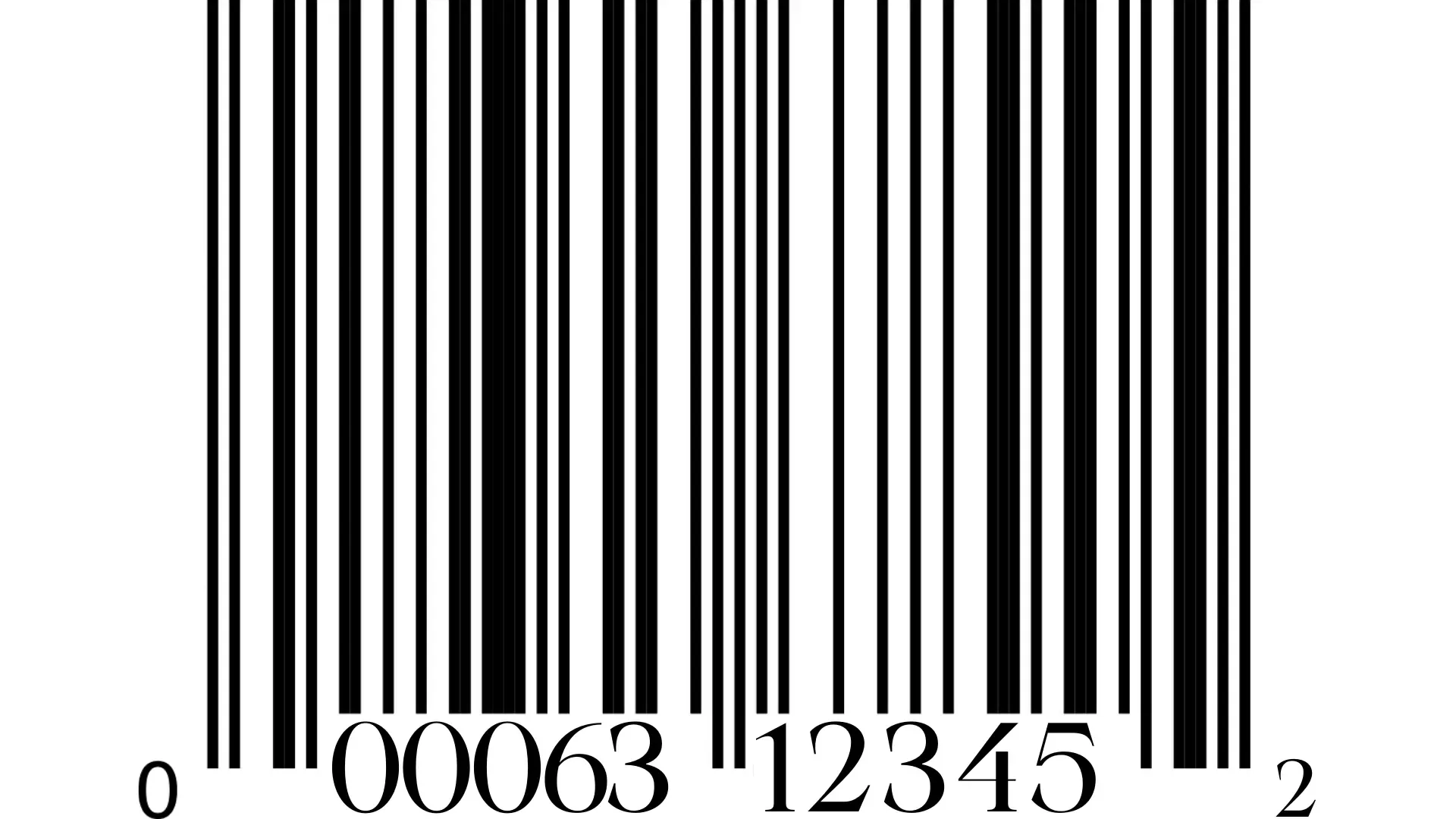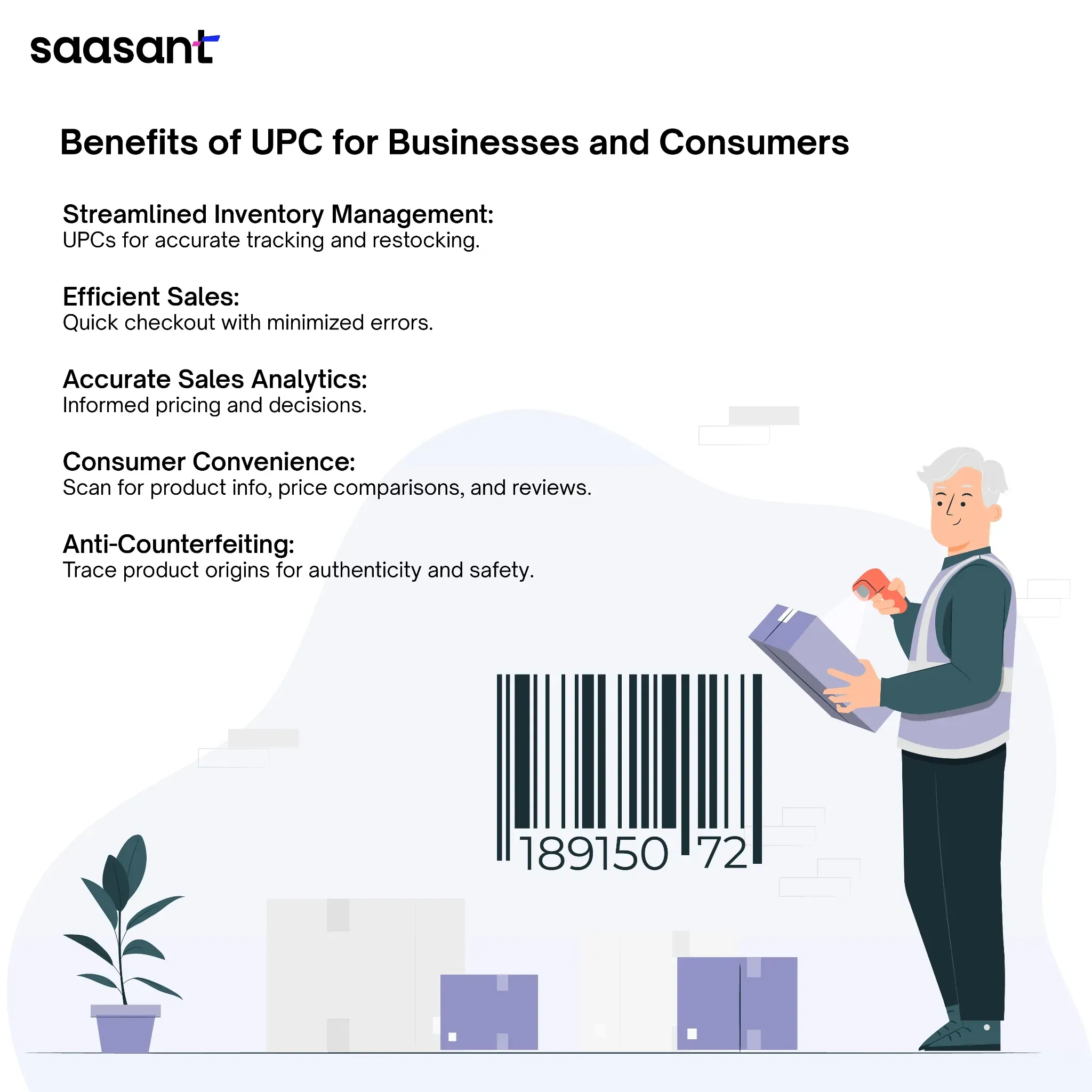Everything You Need to Know About UPCs: A Detailed Guide

In the lightning-fast retail and e-commerce arena, the Universal Product Code (UPC) is pivotal in guaranteeing the smooth transition of products from manufacturers to consumers. Whether you're a business proprietor, a shopper, or anyone curious about the familiar bars on almost every item, this in-depth guide will unravel what’s beneath the black-and-white codes and provide you with the necessary information.
What exactly is a UPC? It's short for Universal Product Code, a standardized barcode with global usage that uniquely identifies products. You've likely encountered UPCs during your shopping spree, but their significance extends far beyond the realm of the checkout counter. These modest black-and-white patterns conceal a treasure trove of product details and are the cornerstone of modern retail and inventory management.
Contents
What is a UPC, and Why is it Important?
The Components of a UPC Code
UPCs vs. Other Product Codes
How UPCs Benefit Businesses and Consumers?
Obtaining UPCs for Your Products
Generating and Printing UPC Barcodes
UPC Lookup: Finding and Verifying Product Codes
The Future of UPCs and Emerging Technologies
Conclusion
Frequently Asked Questions
What is a UPC, and Why is it Important?
A Universal Product Code (UPC) serves as a distinct and universal tag for a product. These UPCs comprise a combination of bars and numbers designed to encode vital information. They are critical when these codes are scanned at the point of sale, whether at a physical store's checkout counter or during an online transaction.
The primary mission of UPCs is to streamline the retail process in our digital world. With a unique UPC assigned to each product, businesses can ensure that their inventory is efficiently managed and accurately tracked. When a consumer makes a purchase, the UPC is swiftly and accurately identified, facilitating smooth transactions and reducing the likelihood of errors. In essence, UPCs are the glue that binds the world of retail, ensuring that products reach consumers with precision.
UPC Format and Encoding
Comprehending the format of a Universal Product Code (UPC) is fundamental to making sense of this unique barcode system. Typically, a UPC consists of two primary components: the manufacturer or company prefix and the product number. These components work in tandem to convey essential information about the product, including the manufacturer's identity and detailed product specifications.
1. Manufacturer or Company Prefix: The manufacturer or company responsible for the product is assigned the initial part of the UPC. It serves as a unique identifier for the manufacturer, ensuring that products from different companies have distinct UPCs. This prefix can vary in length, with shorter prefixes indicating more prominent manufacturers or companies with multiple product lines.
2. Product Number: The product number is the second segment of the UPC and is specific to the individual product or item. It differentiates various products produced by the same manufacturer. Think of it as a product's unique fingerprint within the manufacturer's catalog. The product number is often longer than the manufacturer prefix, allowing for various unique combinations.
The Components of a UPC Code
Let's learn about the core nature of a UPC, dissecting its structure and decoding the essential components that make it a universal identifier.
Breaking Down the Elements
Let's dive deeper into a UPC's structure:
Manufacturer Code: This part of the UPC identifies the manufacturer or company that produces the product.
Example: Let's say the manufacturer of a product is Apple Inc. The manufacturer code assigned to Apple might be "000063" (this is a sample code).
Product Code: The product code uniquely identifies the specific item or variation.4
For example, if Apple manufactures an iPhone 12 Pro Max with a specific color and storage capacity, the product code for that particular model might be "12345" (this, too, is a sample code).
Check Digit: A single digit at the end of the code ensures the accuracy of the UPC.
Example: Calculate check digit using a specific algorithm: "2."
Putting it all together:
Manufacturer Code: 000063
Product Code: 12345
Check Digit: 2
So, if we combine these elements, the complete UPC for the specific iPhone 12 Pro Max model from Apple might look like this:

Note: All the product names and codes are for sample purposes only.
UPCs vs. Other Product Codes
Regarding product identification, UPCs, or Universal Product Codes, are just one piece of the puzzle. Various other product codes like EAN ISBN exist; each serves a distinct purpose and varies geographically. So, knowing the differences between these codes is critical for quickly exploring the diverse terrains of global commerce.
Let's explore how UPCs stack up against other product codes and where they each find their unique applications.
What Sets UPCs Apart?
While UPCs are widely recognized, they coexist with other significant product identification codes:
UPC (Universal Product Code): Comprising 12 numeric digits, UPCs are prevalent in retail environments, primarily in North America, facilitating efficient product tracking and sales management.
EAN (European Article Number): Similar to UPCs but with 13 digits, EANs are predominantly used in Europe and globally, enhancing product tracking and sales in various regions.
ISBN (International Standard Book Number): Dedicated to books, ISBNs consist of 10 or 13 digits, uniquely identifying each book edition, crucial for the book industry's inventory management and sales.
How UPCs Benefit Businesses and Consumers?

UPCs offer significant advantages to both businesses and consumers:
Streamlined Inventory Management: UPCs enable seamless inventory management, ensuring accurate tracking and timely restocking.
Efficient Sales Transactions: At the checkout counter, UPCs expedite sales by minimizing errors associated with manual entry.
Accurate Sales Analytics: Businesses can analyze sales trends, adjust pricing strategies, and make data-driven decisions.
Consumer Convenience: Shoppers can access detailed product information, compare prices, and read reviews by scanning UPCs with smartphones.
Anti-Counterfeiting Measures: UPCs help trace product origins, ensuring authenticity and consumer safety.
Obtaining UPCs for Your Products
Let's learn the process of obtaining Universal Product Codes (UPCs) for your products:
Determine the Number of UPCs Needed: Each distinct product variation or unique product requires its own UPC.
Choose a GS1 Membership or a Reseller: Obtain UPCs directly from GS1 by becoming a member for greater control, or purchase them from authorized resellers for affordability.
Apply for UPCs: Follow the respective process for GS1 membership or reseller purchase to acquire UPCs.
Assign UPCs to Products: Associate each UPC with the corresponding product in your inventory.
Implement UPCs: Incorporate UPCs into your packaging or labels for retail and online sales.
Keep UPC Records: Maintain accurate records of UPC assignments and product associations for effective tracking and management.
The Registration Process
Securing a Universal Product Code (UPC) is essential when launching a new product. This UPC serves as a unique identifier for your product, ensuring seamless tracking, inventory management, and compatibility with retail systems. To obtain a UPC, you'll need to navigate a process that involves registering with GS1, the organization responsible for establishing and maintaining UPC standards.
1. Understand the Significance of a UPC:
Before diving into the process, it's essential to grasp why a UPC is necessary. A UPC is like a product's digital fingerprint, providing a distinct code that retailers and online marketplaces use to identify and list your product. It streamlines inventory management and simplifies the shopping experience for customers.
2 The number of UPCs You Require:
Consider the different variations or unique products within your product line that require individual identification. Each distinct product, color, size, or packaging may necessitate its own UPC.
3. Register with GS1:
GS1 is the global organization responsible for maintaining UPC standards. Registering with GS1 is the most direct and authoritative way to obtain UPCs.
Visit the GS1 website (www.gs1.org) to find your country's GS1 office or branch. GS1 operates globally, and each country has its own GS1 authority.
Register your company with your country's GS1 office. This registration typically involves providing business information and paying a one-time membership fee.
Upon registration, you will receive a unique company prefix, which forms the first part of your UPCs.
4. Create Individual UPCs:
With your assigned company prefix from GS1, you can now generate individual UPCs for each product. The process often involves using the GS1 online portal or software provided by GS1.
5. Associate UPCs with Products:
Once you have your UPCs, associate each with the corresponding product in your inventory. It ensures the retrieval of correct product information after scanning the barcode.
6. Incorporate UPCs into Product Packaging:
Include the UPC barcodes on your product packaging or labels. These barcodes must be clear and scannable.
7. Utilize UPCs for Sales:
Now equipped with UPCs, your products are ready to be listed for sale in retail stores and on various online platforms. UPCs facilitate accurate sales tracking and inventory management.
8. Maintain Records:
Keep meticulous records of your UPC assignments and product associations. This documentation is crucial for managing and tracking your products efficiently.
Generating and Printing UPC Barcodes
Businesses have several methods and tools for generating and printing UPC barcodes:
GS1 Membership: Become a GS1 member to obtain globally recognized UPCs following industry standards.
Barcode Generation Software: Use dedicated software for creating and customizing UPCs, simplifying the process.
Point-of-Sale (POS) Systems: Generate UPC barcodes directly from POS systems, ideal for physical storefronts.
Barcode Printers: Utilize specialized barcode printers for high-quality, bulk barcode production.
Online Barcode Generators: Access free online tools for occasional barcode needs, providing quick and cost-effective solutions.
Label Design Software: Design custom labels with UPC barcodes using label design software.
Outsourcing: Consider outsourcing barcode printing to specialized companies for extensive labeling requirements.
Mobile Apps: Explore mobile apps for generating QR codes, offering an alternative for quick access to product details.
UPC Lookup: Finding and Verifying Product Codes
In simple terms, UPC Lookup is a way to find information about a product using its unique code. Imagine this code as a product's ID or fingerprint. Whether you're a shopper looking for details about a product or a business trying to ensure your product information is accurate, UPC Lookup comes to your rescue.
Here's how it works:
The Role of a UPC: Every product has a Universal Product Code (UPC), a special code that makes it unique. It consists of numbers and a barcode. Businesses use this code for various purposes like tracking, managing inventory, and pricing.
Why UPC Lookup Matters: UPC Lookup is handy when you want to know more about a product or confirm if its information is correct. It's like double-checking details. Whether you're a curious shopper interested in product specs or a business wanting to ensure your data is precise, UPC Lookup helps you do this.
Methods for UPC Lookup: You have several ways to do UPC Lookup:
Online UPC Databases: Many websites are exclusive to UPC Lookup. You enter the UPC, and it reveals information about the product, such as its name, brand, manufacturer, and sometimes even user reviews.
Mobile Apps: There are apps designed for scanning UPCs using your smartphone's camera. They quickly provide detailed information about the product.
Retailer Websites: Some stores offer tools on their websites for UPC Lookup. It helps you verify product details or check if the item is available in a particular store.
Consumer Empowerment: For shoppers, UPC Lookup is empowering. It lets you make informed buying decisions. You can swiftly access product specifications, compare prices, and read reviews to ensure you get what you want.
Business Benefits: Businesses also gain a lot from UPC Lookup. It's a valuable tool to verify that the product information in their records is correct. It is crucial for managing inventory supply chains and maintaining accurate online listings.
The Power of UPC Verification: UPC Lookup isn't just about getting information; it's a powerful tool for confirming that the product codes match the correct products. It helps avoid errors in databases.
Data Enrichment and Accuracy: UPC Lookup can be part of a broader strategy to improve data quality. It helps businesses keep their product databases up-to-date and accurate, enhancing their operations and customer experiences.
Understanding UPC Lookup
UPC lookup methods and tools simplify the process of accessing product information and verifying data accuracy:
Online UPC Databases: Access dedicated online databases for quick product information retrieval, including name, brand, manufacturer, and user reviews.
Mobile Apps: Use UPC scanning apps to retrieve detailed product insights through smartphone cameras.
Retailer Websites: Verify product details or in-store availability through retailer websites.
UPC lookup empowers consumers to make informed purchasing decisions and aids businesses in ensuring data precision.
The Future of UPCs and Emerging Technologies
As technology continues to evolve rapidly, so does product identification. In this section, we'll embark on a journey into the future of Universal Product Codes (UPCs) and explore how emerging technologies are reshaping how we label and track products. From RFID to QR codes and beyond, let’s delve into the exciting possibilities and potential implications that await the world of product coding and tracking.
Evolving with Technology
The product coding and tracking landscape is undergoing significant transformations as technology advances. Two emerging trends shaping the future of product identification are Radio-Frequency Identification (RFID) and QR codes.
RFID (Radio-Frequency Identification): RFID technology involves radio waves communicating data between tags or labels attached to products and a reader device. Unlike traditional barcodes, RFID tags can be read without direct line-of-sight, allowing quick and automated data capture. This technology is already used in various industries, including retail, logistics, and healthcare, to improve inventory management, track assets, and enhance supply chain visibility. In the retail sector, RFID can lead to more accurate inventory counts, reduced out-of-stock incidents, and increased efficiency in managing products from the distribution center to the store shelves. As RFID technology becomes more affordable and widespread, it has the potential to revolutionize product coding and tracking across industries.
QR Codes (Quick Response Codes): QR codes are two-dimensional barcodes that can store a wide range of information, including web links, text, and contact details. They have gained popularity due to their versatility and ease of use, with consumers scanning QR codes using their smartphones for various purposes. Regarding product coding, QR codes offer the advantage of holding extensive data, allowing businesses to provide consumers with detailed product information, user manuals, and promotional content. QR codes can enhance the consumer experience by enabling quick access to product-related information and interactive features. You can use tools like the QR Code generator for easy information retrieval.
Conclusion
UPCs are essential in retail, connecting products to information and streamlining the shopping experience for businesses and consumers. Understanding and efficiently managing UPCs can significantly impact your business's success.
Frequently Asked Questions
What does UPC stand for, and why is it important in retail and e-commerce?
UPC stands for Universal Product Code. It is vital in retail and e-commerce because it is a standardized barcode to uniquely identify products, facilitating efficient inventory management and smooth transactions.
How is a Universal Product Code (UPC) structured, and what information does it encode?
A UPC typically consists of a manufacturer or company prefix and a product number. The manufacturer prefix identifies the producer, while the product number specifies the individual item's details.
What distinguishes UPCs from other product identification codes like EAN and ISBN?
UPCs are used globally and are primarily for retail products. EAN and ISBN have different applications and may vary by region.
How do UPCs benefit both businesses and consumers in the retail industry?
UPCs streamline inventory management, enhance checkout processes, and simplify consumer price comparisons, offering efficiency and convenience.
What is the process for obtaining UPCs for new products, and do I need them for all my products?
Register with GS1, the organization responsible for UPC standards, to obtain UPCs. Whether you need UPCs for all products depends on your business strategy.
What methods and tools can businesses use to generate and print UPC barcodes?
Businesses can generate and print UPC barcodes using various software tools and techniques to maintain control over product identification.
How can I perform a UPC lookup to find and verify product codes?
UPC lookup methods and online resources allow you to access product details and verify data accuracy.
What emerging technologies are shaping the future of UPCs and product identification?
Emerging technologies like RFID and QR codes influence UPCs' evolution, offering new product coding and tracking possibilities.